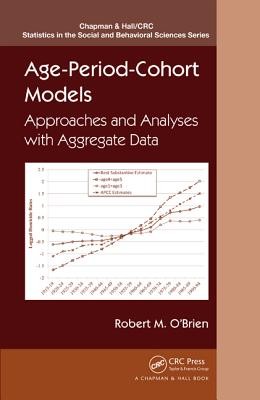
- We will send in 10–14 business days.
- Author: Robert O'Brien
- Publisher: CRC Press
- ISBN-10: 1466551534
- ISBN-13: 9781466551534
- Format: 16.3 x 23.4 x 1.8 cm, hardcover
- Language: English
- SAVE -10% with code: EXTRA
Reviews
Description
Develop a Deep Understanding of the Statistical Issues of APC Analysis
Age-Period-Cohort Models: Approaches and Analyses with Aggregate Data presents an introduction to the problems and strategies for modeling age, period, and cohort (APC) effects for aggregate-level data. These strategies include constrained estimation, the use of age and/or period and/or cohort characteristics, estimable functions, variance decomposition, and a new technique called the s-constraint approach.
See How Common Methods Are Related to Each Other
After a general and wide-ranging introductory chapter, the book explains the identification problem from algebraic and geometric perspectives and discusses constrained regression. It then covers important strategies that provide information that does not directly depend on the constraints used to identify the APC model. The final chapter presents a specific empirical example showing that a combination of the approaches can make a compelling case for particular APC effects.
Get Answers to Questions about the Relationships of Ages, Periods, and Cohorts to Important Substantive Variables
This book incorporates several APC approaches into one resource, emphasizing both their geometry and algebra. This integrated presentation helps researchers effectively judge the strengths and weaknesses of the methods, which should lead to better future research and better interpretation of existing research.
EXTRA 10 % discount with code: EXTRA
The promotion ends in 19d.17:36:39
The discount code is valid when purchasing from 10 €. Discounts do not stack.
- Author: Robert O'Brien
- Publisher: CRC Press
- ISBN-10: 1466551534
- ISBN-13: 9781466551534
- Format: 16.3 x 23.4 x 1.8 cm, hardcover
- Language: English English
Develop a Deep Understanding of the Statistical Issues of APC Analysis
Age-Period-Cohort Models: Approaches and Analyses with Aggregate Data presents an introduction to the problems and strategies for modeling age, period, and cohort (APC) effects for aggregate-level data. These strategies include constrained estimation, the use of age and/or period and/or cohort characteristics, estimable functions, variance decomposition, and a new technique called the s-constraint approach.
See How Common Methods Are Related to Each Other
After a general and wide-ranging introductory chapter, the book explains the identification problem from algebraic and geometric perspectives and discusses constrained regression. It then covers important strategies that provide information that does not directly depend on the constraints used to identify the APC model. The final chapter presents a specific empirical example showing that a combination of the approaches can make a compelling case for particular APC effects.
Get Answers to Questions about the Relationships of Ages, Periods, and Cohorts to Important Substantive Variables
This book incorporates several APC approaches into one resource, emphasizing both their geometry and algebra. This integrated presentation helps researchers effectively judge the strengths and weaknesses of the methods, which should lead to better future research and better interpretation of existing research.


Reviews